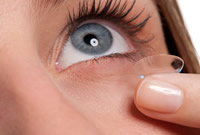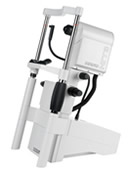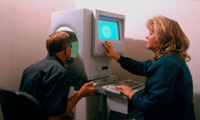 Over 140 million people in the U.S. wear eyeglasses and over 30 million wear contact lenses. Glasses and contact lenses improve vision by adjusting the way the eyes bend and focus light. Ideally, light rays are refracted (bent) as they pass through the cornea so that they focus on the retina in the back of the eye. In a healthy eye, this means that objects can be seen clearly. However, many people's corneas have a shallow or steep curvature, which causes light rays to focus in front of or behind the retina. Objects may then appear blurry at certain distances or at all distances.
Over 140 million people in the U.S. wear eyeglasses and over 30 million wear contact lenses. Glasses and contact lenses improve vision by adjusting the way the eyes bend and focus light. Ideally, light rays are refracted (bent) as they pass through the cornea so that they focus on the retina in the back of the eye. In a healthy eye, this means that objects can be seen clearly. However, many people's corneas have a shallow or steep curvature, which causes light rays to focus in front of or behind the retina. Objects may then appear blurry at certain distances or at all distances.
Glasses and contact lenses correct these refractive errors. Prescriptions are measured for each eye so patients can enjoy optimal vision clarity, usually 20/20. Eyewear may be used for certain activities, such as reading for farsighted (hyperopic) patients and driving or watching television for nearsighted (myopic) patients, or may be worn at all times.
Regular eye exams test for the development and progression of refractive errors and help your doctor provide a proper prescription if eyeglasses or contact lenses are needed. Exams are also an invaluable tool in the early detection of eye disease.
We have relationships with several optical boutiques that can help you find the ideal eyewear for your needs. Computer glasses, backup glasses for contact wearers’, readers and no line bifocals in addition to other new lens technology and fashion frames are available to suit all budgets. Many of these opticians may participate with your vision plan.
Today, there are so many contact lens options for every age and vision need. We can correct nearsightedness, farsightedness, and astigmatism. Our lenses can provide monovision, replace your bi-focals or give older patients multifocal lenses that allow them to see near, mid and far distances. If you are an avid sports player, we even have lenses that help sharpen your vision to give you that extra competitive edge.
With colored lenses, you can change your look from lens to lens. We can order different colors to suite your different moods. To determine the best lens for you, we will conduct a thorough eye exam and discuss all the options with you. Schedule an appointment with us and free yourself of glasses! You’ll be surprised how comfortable and easy they are to use and how they’ll change your life.
We evaluate, fit, teach, train and dispense contact lenses in our office. The fitting appointment, which is separate from your thorough eye exam, includes a trial set of lenses, instructions on wearing and maintaining your lenses, a training session on insertion and follow up appointments.
Optical coherence tomography (OCT) is an advanced technology used to produce cross-sectional images of the retina, the light-sensitive lining on the back of the eye where light rays focus to produce vision. These images can help with the detection and treatment of serious eye condition such as macular holes, macular swelling and optic nerve damage.
OCT uses technology that is similar to CT scans of internal organs, using a scattering of light to rapidly scan the eye to create an accurate cross-section. Unlike other imaging techniques, OCT uses light to produce high resolution images, rather than sound or radiofrequency waves. Your doctor can evaluate and measure each layer of the retina through this image and compare it with normal, healthy images of the retina.
The OCT exam takes about 10 to 20 minutes to perform in your doctor's office, and usually requires dilation of the pupils for the best results.
 The high eye pressure associated with glaucoma can damage your optic nerve before you begin to experience any vision loss. The Heidelberg Retinal Tomograph (HRT) can digitally perceive damage that may indicate the onset of glaucoma, allowing treatment to begin before vision is lost. Similar to MRI (Magnetic Resonance Imaging) and CT (Computed Tomography), HRT is a non-invasive procedure that scans the eye - all you see is a series of flashing red lights. The HRT takes 3-dimensional photographs of the optic nerve and retina using a special laser. It starts by photographing the surface of the optic nerve and then focuses on deeper and deeper layers before putting them all together to create the 3-dimensional image. These photographs can be used to determine the retinal edema index, retinal thickness and a reflectance map, which reveals retinal abnormalities.
The high eye pressure associated with glaucoma can damage your optic nerve before you begin to experience any vision loss. The Heidelberg Retinal Tomograph (HRT) can digitally perceive damage that may indicate the onset of glaucoma, allowing treatment to begin before vision is lost. Similar to MRI (Magnetic Resonance Imaging) and CT (Computed Tomography), HRT is a non-invasive procedure that scans the eye - all you see is a series of flashing red lights. The HRT takes 3-dimensional photographs of the optic nerve and retina using a special laser. It starts by photographing the surface of the optic nerve and then focuses on deeper and deeper layers before putting them all together to create the 3-dimensional image. These photographs can be used to determine the retinal edema index, retinal thickness and a reflectance map, which reveals retinal abnormalities.
 The Humphrey Visual Field is a special automated procedure used to perform perimetry, a test that measures the entire area of peripheral vision that can be seen while the eye is focused on a central point. During this test, lights of varying intensities appear in different parts of the visual field while the patient's eye is focused on a certain spot. The perception of these lights is charted and then compared to results of a healthy eye at the same age of the patient in order to determine if any damage has occurred.
The Humphrey Visual Field is a special automated procedure used to perform perimetry, a test that measures the entire area of peripheral vision that can be seen while the eye is focused on a central point. During this test, lights of varying intensities appear in different parts of the visual field while the patient's eye is focused on a certain spot. The perception of these lights is charted and then compared to results of a healthy eye at the same age of the patient in order to determine if any damage has occurred.
This procedure is performed quickly and easily in about 15 minutes, and is effective in diagnosing and monitoring the progress of glaucoma. The Humphrey system uses advanced blue-yellow perimetry, also known as Short Wavelength Automated Perimetry (SWAP), which is proven to detect signs of glaucoma-related vision loss earlier than other tests.
Patients with glaucoma will often undergo this test on a regular basis in order to determine how quickly the disease is progressing. The Humphrey Visual Field test can also be used to detect conditions within the optic nerve of the eye, and certain neurological conditions as well.